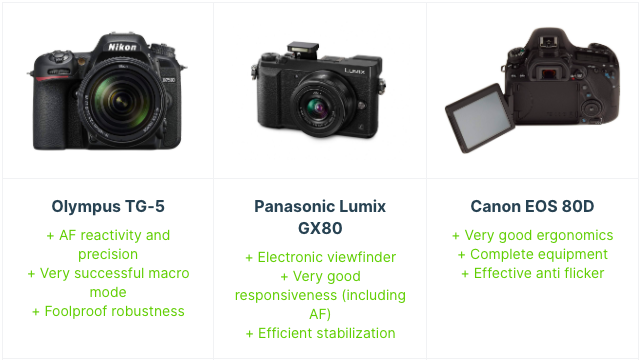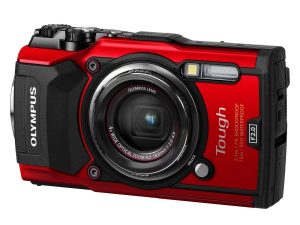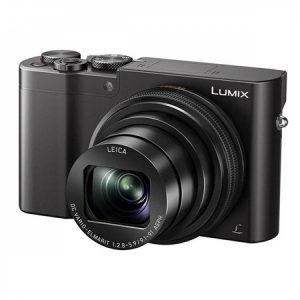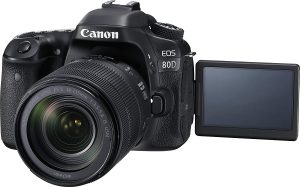Business
Best Cameras in 2020

Even if the competition offered by smartphones is increasingly important, the camera remains today a consumer product.
However, this new competition has pushed brands to rework their ranges, while new formats, hybrids or instant cameras are being developed. To see more clearly in this complex offer, we offer you a complete guide, which should allow you to equip yourself as closely as possible to your needs.
What are the best cameras in 2020?
Olympus TG-5, the best compact

Released in the summer of 2017, this compact was the first waterproof model to support 4K video. You will understand, we fell in love with a model so versatile that it is able to follow you in the water (up to 15 m deep according to Olympus, IPX8 certification in support), to fall from 2 m high, to withstand a temperature of -10 ° C or to support a load of 100 kg. Designed for photo adventurers, it even has a GPS, pressure gauge, compass and anti-fog double glazing.
We reassure you, it is not only his little tank side that convinced us but also and above all his very good skills in terms of the quality of the photos produced. The autofocus is precise and responsive, the camera is capable of
So certainly, the image would benefit from being more homogeneous and seems to lack a little sharpness (details) at the end of the zoom (x4, in this case). And the rise in sensitivity remains limited for a device purchased in 2019. The fault, overall, to a manufacturer who is resting on its laurels. But it must be said that its product is very good and that there is little competition in this segment. So while waiting for a possible TG-6, you can opt for this particularly versatile compact.

Released in 2016, this mirrorless camera has since seen a significant price drop. Formerly marketed at 599 euros naked, it is today under 400 euros. And even at 420 euros in a kit with the Lumix G Vario 12-32 mm zoom (f / 3.5-5.6). At this price, you can afford a discreet compact (by its dimensions as by its shutter, a model of silence), equipped with an electronic viewfinder, an adjustable touch screen, of flawless build quality (even if it is not tropicalized).
As comfortable in the video (4K capture) as in photos, the Lumix GX80 benefits from excellent responsiveness, but also and above all from very good stabilization, which works as well on the photo part as on the video part. .
Its accessory shoe allows the addition of an additional flash, even if Panasonic has integrated one in its compact hybrid. What also to compensate for the absence of a microphone jack/headphone jack, which would have allowed the device to exploit all its (excellent) potential in the video.
Only real regret: a little low autonomy which will force you not to move too far from an electrical outlet …
Fujifilm Instax Mini 90 Neo Classic, the best snapshot
Among Fujifilm’s Instax Mini range, the 90 Neo Classic is the best equipped. This instant camera is first of all the only one in its family to be powered by a rechargeable battery and not by batteries. It also has, and jumbled up, a macro mode, an exposure correction (on three levels), a self-timer (one-shot or double shot mode, with a delay of 10 seconds), offers flash control (which can be turned off), and offers a small screen showing the current settings and the number of exposures remaining.
Fujifilm has even provided a Mode button that will further enhance the playful side of the camera since it gives you access to presets designed to adapt to different situations: party, landscape, children, double exposure or long exposure (bulb). Depending on your choices, the device will make the necessary adjustments without any intervention on your part.
An elegant case (coated with a black or brown imitation leather coating), which allows a certain dose of creativity, but which is however not without flaws: the exposure is not always the most accurate, and the viewfinder is somewhat narrow. But around 100 euros at some merchants, it remains one of the best instant cameras on the market.
Canon EOS 80D, the best SLR

The Canon EOS 80D, however, released in the summer of 2016, remains today an excellent choice in the segment of SLR cameras. Pleasant handling (in particular thanks to a well-thought-out handle and a modest weight), a touch screen that displays very well-thought-out menus, a 100% pentaprism viewfinder … The EOS 80D suffers only from very few defects of the point of view of general ergonomics, if not a central pad and a rear dial which do not seem very pleasant to use.
For the rest, it is equipped with features specific to its price range: intervalometer, Wi-Fi, NFC … Connectivity that allows remote control of video mode, which takes advantage of a headphone jack, a plug microphone, and 60p capture, for effective subject tracking, while autofocus is particularly precise and responsive. Too bad Canon has overlooked 4K.
Equipped with a 24-megapixel APS-C sensor, the Canon EOS 80D works on a sensitivity range going from 100 to 16,000 ISO (and even 25,600 ISO by extension), captures in RAW on-demand, offers 45 points ( and still 27 at f / 8), and has a particularly effective anti-flicker mode. Of course, the quality of the images produced is excellent. But this is no surprise for this range of
Best compact camera
Even in competition with smartphones, compact models are still popular. Their small size sometimes hides impressive and powerful zooms, as well as advanced features. Are you looking to equip yourself with one of these models? Discover our selection of the best compact cameras
Best mirrorless camera
Hybrid models are not the best known. Perhaps because they are rather recent compared to compacts or SLRs, which they try to marry the two worlds, offering excellent performance in a container format. Are you interested in this type of model? Discover our selection of the best mirrorless cameras!
Best instant camera
Instant models are, particularly in vogue. Their retro side like that of the clichés produced is particularly popular with nostalgic people who have known old devices of this type, but also by the youngest, used to Instagram filters. Are you interested in this type of model? Discover our selection of the best instant cameras!
Best SLR Camera
The SLRs try to keep their audience facing hybrids that are ever closer in terms of image quality. To compete with this new kind of cameras, the full-frame is gaining ground, and entry-level models are less and less expensive. Are you interested in this type of model? Discover our selection of the best SLR cameras!
Which camera to choose?
To answer this question, it makes you identify your photographer profile. Are you looking for family use, an everyday device that will be handled by you as well as by your children? Do you prefer the nomadic aspect, with a (very) small size model, which will accompany you on all your travels? Are you aiming for the device that will allow you to develop smoothly in your photography practice? Or are you already a seasoned photographer, and looking for the product that best suits your (long) list of criteria? Unless you are looking for the device that will accompany you in the evening, the one that will be synonymous with fun and pleasure for you.
Anyway, and despite the competition from smartphones, camera lines today are still wide enough that you can find something that fits.
You do not really know in which category of user you fall? We have designed small robot portraits for you so that you can recognize yourself in these different profiles.
Profile # 1: only the essentials!
– Your first criterion is financial and your objective is to stay below the 150 euros mark.
– You don’t want to learn photography, and above all seek simplicity: the fewer buttons, the better! The camera should handle the image alone, you just have to trigger.
– You are not an esthete of the photo that you do not scrutinize with a magnifying glass, and you definitely do not intend to post-process them.
– Your photos carry a memory, and it’s that moment that interests you, not the quality of the photo itself.
– To enhance these memories, you are not against some playful effects that allow you to use your photos on social networks, for example.
> You need an entry-level compact camera
Profile # 2: Versatility as the watchword
– Price is still an important criterion for you, but you fear that the entry-level is too limited. So you are ready to invest a little more.
– You need a light device,
– By the way, you need a big zoom, covering the wide-angle to telephoto, but without sacrificing compactness (no bridges).
– The presence of a GPS is desirable in order to locate my pictures, in particular within the framework of trips or displacements.
– Also in this context, video is an important element for you, as is a certain aptitude of the camera for creative photos.
– You are attracted to photography and want to go a little further than the fully automatic mode, without however falling into something too complex.
> Go for a versatile compact.
Profile # 3: Quality and Versatility
– You’ve had compact cameras before and want to take it up a notch.
– You especially want to have more control, with a real desire for improvement in photography.
– And for good reason: you are demanding as to the quality of your shots and want a result close to what an SLR could offer.
– Besides, you are also tempted by photo editing, at least from time to time.
– On the usage side, you like to take pictures in low light or play with depth of field when composing your images.
– However, reflexes put you off because of their size and the obligation to change optics depending on the circumstances.
> An expert compact with a large sensor would be a good answer to your needs.
Profile # 4: here and now!
– For you, photography is seen differently than on a screen: it is the physical memory that interests you.
– You like photo paper.
– You are ready to devote a significant amount of money to get your photos out of your camera on this photo paper. You want to have fun and recreational use of your camera above all.
– You are not particularly interested in the disengaged modes of expert reflex, hybrid or compact cameras and aim for simplicity.
> You have to turn to instant cameras.
Profile # 5: excellence and compactness
– You want impeccable image quality, equivalent to that of an SLR. – Occasionally you shoot in low light conditions. – You like to play with depth of field when composing your images.
– Besides, you don’t hesitate to spend time in post-processing.
– As with an SLR, you like the idea of having dedicated lenses, or of being able to upgrade your optical equipment.
– You are not afraid to walk around with several optics in your bag.
– You are also very attached to the quality of the video.
– You are ready to devote a substantial budget to your device.
– On the other hand, you are not ready to have an SLR in your hands, which is too bulky for your taste.
> Go for a hybrid device.
Profile # 6: Quality is everything
– You want the best in image quality and performance.
– Heavy and bulky equipment does not scare you.
– You need reflex sight and fast autofocus to be able to shoot as fast as possible.
– Ergonomics and handling are very important elements for you.
– You are not interested in the creative modes which give an artificial side to the photo. You are the master of your shot and no one else!
– You shoot all kinds of subjects, in all light conditions.
– You like to play with depth of field when composing your photos.
– You are used to processing your photos after the fact with specialized software.
– You already have lenses that you want to reuse.
– You are ready to invest a substantial (or even very substantial) budget.
> Choose a reflex camera
Camera comparison: the criteria to check
You are now better oriented on the type of device to select. Now it will be time to dive into the technical sheet to refine your choice.
The first thing to know: the number of photosites of the device, expressed in megapixels, is not a guarantee of image quality. In fact, this figure should be compared to the size of the sensor (expressed in inches), to have a better idea of the image quality produced. Indeed, having 20 or 24 megapixels on a small or even very small sensor is anything but a good idea. Because it involves photosites of ridiculous dimensions, little able to fulfil their role of light sensors/converters (unless you use signal amplification processes which inevitably have an impact on the quality of the light.
Overall, the larger the size of your sensor, the better the potential of your device. A large sensor will notably allow you:
– to obtain shallow depths of field, that is to say, a pronounced and aesthetic background blur, an effect which will be accentuated by certain optics which have large focal lengths and/or a large opening.
– to claim much better performance in low light, because the amplification effect mentioned above will be much less used here.
It is, in reality, all the dynamics of a photo which will be better with a large sensor, which will be able to better manage very contrasted environments (high light in one place, low in the other, as in an undergrowth pierced by light rays Obviously cameras with large sensors (whether compacts, hybrids or SLRs) are more expensive. And often bulkier. But if those two brakes don’t stop you, then you will gain without no doubt about the quality of your image
As a reminder, there are different formats of “large” sensors:
– a full format (or Full Frame)
– an APS-C (which is available depending on the brand)
– a microphone 4 / 3
With a few rare and very expensive exceptions (Sony Alpha 7 and 9 series, Canon EOS RP or Nikon Z 6 and 7), full-frame is reserved for SLR cameras. Some of them, like most hybrids, are equipped with an APS-C sensor. Finally, the 4/3 microphone, developed by Olympus and Panasonic, takes place in some hybrid devices.
In summary, don’t be blinded by a big label proudly displaying a very high number of photosites, but focus on the size of the sensor above all. And if you opt for an entry-level compact, often with a smaller sensor, remember that the fewer photosites there are, the better the quality of your shots.
And the rest of the technical sheet? It all depends on the device you are targeting. The notions of the aperture of the diaphragm or shutter speed, and therefore the availability of “aperture priority” or “speed priority” mode, will not concern compacts, for example, while the presence of pre-programmed creative modes will be theirs. clean. A camera’s ability to capture an image in RAW format will depend on your retouching possibilities, especially in terms of white balance. Weight and size of the cameras are also things to consider carefully, whether you are looking for a pocket-sized compactor, on the contrary, an SLR that weighs in the hand and offers you stability and easy handling. Ergonomics is also a crucial criterion for devices: the presence of two dials or thoughtful menus can tip the scales at the time of purchase. Either way, don’t hesitate to go and try a camera in-store. Spend the time it takes to estimate if its ergonomics suit you, if your hand, your fingers easily find the settings, the different buttons.
A cheap digital camera, a good idea?
Entry-level cameras have been the most neglected with the rise in smartphone photography skills.
Background blur, low light conditions … Today, smartphones can compete with entry-level digital cameras. It is only on the dynamics of the photos (the ability to assume very bright areas, and others in the shade) that small compacts can fetch details absent from the photos taken with the smartphone. And again: it all depends on the smartphone and the device in competition.
Better: some smartphones are now able to capture in RAW, bursts, and offer certain latitudes on settings reserved for enlightened amateurs (especially in terms of increased sensitivity). Responsive, with efficient autofocus, these cameras compete in performance. And the presence on some models of a double sensor allows some fantasies in terms of depth of field. The presence of mobile applications for photo editing encourages even these enlightened amateurs to use their smartphone rather than a dedicated device.
Faced with this rise of smartphones in the photo (and video, by the way) part, camera manufacturers have instead chosen to move upmarket compacts.
Getting a “cheap” digital camera when you have a quality smartphone is therefore probably not a good idea because the images produced will not surpass in quality those obtained using the smartphone.
To make the difference with a smartphone, a compact camera must have a large enough sensor, a retractable screen, an electronic viewfinder, a very versatile zoom. Four devices that smartphones lack and that may encourage you to equip yourself with a dedicated device. But the presence of a large enough sensor, in particular, does not really allow us to consider a truly inexpensive camera.




















































